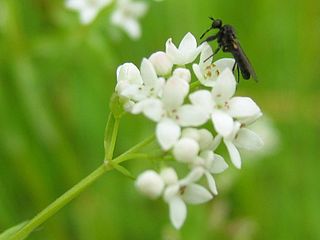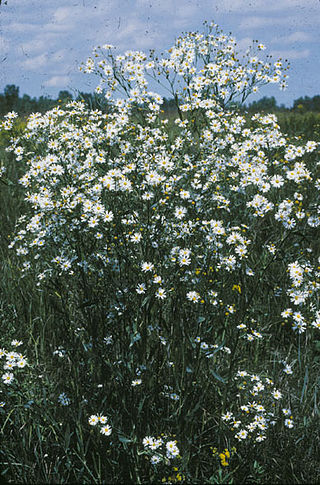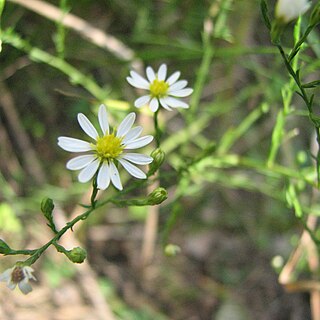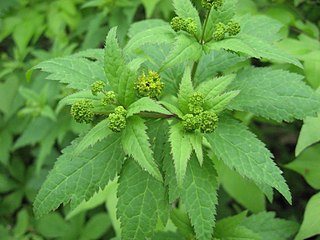
Amianthium is a North American genus of perennial plants growing from bulbs. It contains the single known species Amianthium muscitoxicum, known in English as fly poison from a literal translation of the Latin epithet muscitoxicum, and is noted for its pretty flowers and its toxic alkaloid content. While all parts of the plant are poisonous, the bulb is particularly toxic. The scientific epithet was given to it by Thomas Walter when he published his Flora Caroliniana in 1788.

Vitis aestivalis, the summer grape, or pigeon grape is a species of grape native to eastern North America from southern Ontario east to Maine, west to Oklahoma, and south to Florida and Texas. It is a vigorous vine, growing to 10 m or more high in trees. The leaves are 7–20 cm long, suborbicular, and usually a little broader than long; they are variable in shape, from unlobed to deeply three- or five-lobed, green above, and densely hairy below. The flowers are produced at every 3rd node in a dense panicle 5–15 cm long. The fruit is a small grape 5–14 mm diameter, dark purple or black in colour. It is the official state grape of Missouri. Summer grape prefers a drier upland habitat.

Galium palustre, the common marsh bedstraw or simply marsh-bedstraw, is a herbaceous annual plant of the family Rubiaceae. This plant is widely distributed, native to virtually every country in Europe, plus Morocco, the Azores, Turkey, Turkmenistan, Western Siberia, Greenland, eastern Canada, St. Pierre & Miquelon, and parts of the United States. The species is classified as a noxious weed in New York, Pennsylvania, Massachusetts, Connecticut, Vermont and New Hampshire. It is considered naturalized in Kamchatka, Australia, New Zealand and Argentina.

Boltonia is a genus of plants in the family Asteraceae native primarily to North America with one species in eastern Asia.

Baccharis halimifolia is a North American species of shrubs in the family Asteraceae. It is native to Nova Scotia, the eastern and southern United States, eastern Mexico, the Bahamas, and Cuba.

Erigeron annuus, the annual fleabane, daisy fleabane, or eastern daisy fleabane, is a species of herbaceous flowering plant, annual or biennial, in the family Asteraceae.

Malus angustifolia, or southern crabapple, is a species of crabapple native to the eastern and south-central United States.

Silphium asteriscus, commonly called starry rosinweed, is an herbaceous plant in the family Asteraceae. It is native to the eastern United States, from Oklahoma and Texas east to Florida and Pennsylvania. It is a widespread species found in a variety of open habitats, such as prairies and woodlands.

Eupatorium album, the white thoroughwort, is a herbaceous perennial plant in the family Asteraceae native from the eastern and southern United States, from eastern Texas to Connecticut, inland as far as Indiana.

Symphyotrichum depauperatum, commonly known as serpentine aster or starved aster, is a rare species in the family Asteraceae adapted to serpentine barrens, an ecosystem with a high concentration of toxic metals in the soil. It has been found in Pennsylvania, Maryland, and on some diabase glades in North Carolina. It grows to 50 centimeters and has white ray florets surrounding a center of yellow disk florets.

Gaultheria hispidula, commonly known as the creeping snowberry or moxie-plum, and known to Micmaq tribes of Newfoundland as Manna Teaberry, is a perennial spreading ground-level vine of the heath family Ericaceae. It is native to North America and produces small white edible berries. It fruits from August to September. Its leaves and berries taste and smell like wintergreen.

Uvularia puberula, the mountain bellwort, is a plant species native to the eastern United States. It is common across Virginia, North and South Carolina, West Virginia, and adjacent parts of northern Georgia, eastern Tennessee, eastern Kentucky and southern Pennsylvania. Isolated populations have been found in southern Georgia, northern Alabama, southern New Jersey, and Long Island in New York State.

Sanicula odorata, commonly called the clustered blacksnakeroot, is a flowering plant in the family Apiaceae. It is native and widespread in eastern North America. It grows in nutrient-rich woods, often in mesic forests and bottomlands. It is able to tolerate somewhat degraded habitats, and is not considered a particularly conservative species.

Solidago curtisii, commonly called Curtis' goldenrod and mountain decumbent goldenrod, is a North American species of flowering plants in the family Asteraceae. It is the eastern part of the United States from Pennsylvania to Mississippi and Alabama, primarily in the southern Appalachian Mountains.

Solidago roanensis, the Roan Mountain goldenrod, is a North American species of goldenrod in the family Asteraceae. It is native to the eastern United States, primarily the Appalachian Mountains from Pennsylvania to Georgia, with some populations in the lowlands of South Carolina.
Rubus recurvicaulis is an uncommon North American species of flowering plant in the rose family. It grows in eastern and central Canada and the north-central and northeastern United States.
Rubus vermontanus is a North American species of bristleberry in section Setosi of the genus Rubus, a member of the rose family. It is found in eastern and central Canada and the northeastern and north-central United States.
Rubus uvidus is a North American species of brambles in the rose family. It grows in the province of Québec in eastern Canada, as well as in the northeastern and north-central United States.
Rubus suus is an uncommon North American species of brambles in the rose family. It grows in the eastern and south-central United States from Georgia north to Pennsylvania and Ohio, west to eastern Texas.

Thomas George Gentry was an American educator, ornithologist, naturalist and animal rights writer. Gentry authored an early work applying the term intelligence to plants.
















